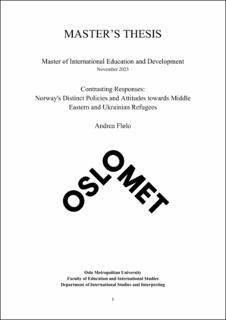| dc.description.abstract | September 2015 and March 2022 marked significant milestones in the history of refugee reception, not only in Norway but also across Europe. These periods witnessed a significant increase in the influx of refugees. In 2015, Norway experienced an extraordinary surge in asylum applications, totalling more than 31,000 claims by the year's end, predominantly from the Middle East. This starkly contrasted the preceding year, which had seen 11,000 claims, and the subsequent year, which recorded a mere 3,000 (UDI, 2023 b: 9). After this peak in 2015, there were years of low influx until a significant spike in 2022, surpassing the 2015 figures, with over 40,000 asylum claims, mainly from Ukraine. This marked the highest number of asylum claims received within a single year in Norway's history, as reported by the Norwegian Directorate of Immigration (UDI, 2023 c). The topic of refugees has long been a subject of extensive political and media discourse. Immigration policies are dynamic, frequently changing, and the events of 2015 gathered significant media attention and political discussions, not just in Norway but throughout Europe. During this period, various measures restricting access to Europe, including the controversial EU-Turkey deal, were implemented. Norway, enforced similar measures. However, in 2022, a starkly different response emerged. All refugees from Ukraine were promptly granted collective protection in Norway, with official policy adjustments made swiftly following their arrival. Similar shifts in policy were observed across Europe. The policy responses in 2015 and 2022, therefore, presented stark contrasts to each other. This research project delves into the different approaches adopted by Norway in responding to two distinct refugee crises: the post-2015 influx of refugees from the Middle East and the 2022 Ukrainian refugee crisis. The study explores changes in legislation and policies, the actual experiences of refugees within Norway, and the evolving attitudes towards these refugees. To examine these responses, the study employs a qualitative research approach, incorporating interviews with organisations, journalists, politicians and writes, as well as policy document analysis. The research questions compare how legislation accommodated Ukrainian and Middle Eastern refugee groups, and how these identified disparities influenced the integration process in Norway. The findings suggest that Norway's response to the Ukrainian refugee crisis demonstrates a higher degree of openness and willingness to accommodate refugees compared to the earlier influx of refugees from Middle Eastern countries. This shift is evident in both political attitudes and the reception of refugees within local communities. The research uncovers significant changes in legislation that reflect these altered perspectives. Additionally, the study highlights the role of media and public attitudes in shaping Norway's response to refugees. Despite both refugee groups experiencing the hardships of war and displacement, this research seeks to comprehend why varying attitudes and actions have emerged towards them. The study's significance is underscored by its contribution to the ongoing debates about the presence of racism, and prejudice, in refugee and asylum policies in European countries, including Norway. By analysing Norway's contrasting responses to these two refugee crises, this thesis sheds light on the factors influencing policy-making decisions and public perceptions concerning refugees. | en_US |
